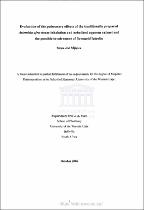| dc.description.abstract | Artemisia afra is a popular medicinal plant traditionally used to treat respiratory conditions such as asthma, bronchitis etc., most frequently as a steam inhalation. The effectiveness of this steam inhalation, its active constituent(s), and the disposition of the latter has not yet been evaluated. The plant, however, contains appreciable amounts of flavonoids, such as luteolin, that are potential markers for use in the
evaluation of the pulmonary effects of the plant, in a model such as the isolated perfused rat lung (IPL). The objectives of this study were, firstly to compare the luteolin content in dried crude A. afra leaves and an aqueous extract of A. afra; secondly, to compare the pulmonary effects of the traditionally-prepared A. afra steam inhalation and nebulized A. afra aqueous extract and luteolin solutions; and thirdly, to determine the pulmonary disposition and effect of intravenously administered luteolin. To realize these objectives, aqueous extract of A. afra was prepared according to the traditional healers method. Luteolin contents of the plant solutions and perfusion medium were determined using HPLC. The IPL model was adapted to allow administration via steam inhalation and nebulization, as well as the monitoring of
pulmonary function tidal volume (TV), respiratory resistance (RL) and compliance (CL). To determine the pulmonary disposition, luteolin was administered in the perfusion medium, perfusate samples taken over an hour and half, and assessed for luteolin content. The traditionally prepared A. ofra extract contained significantly (p<0.001) higher luteolin levels (49. 554 + 0.4021p,g125m9, n:5) than the A. afra crude dried leaves (15. 939 + 1.1829 p,gl25mg, n:5) indicating that the aqueous extraction process concentrated the plant's active constituents. Lung preparations remained stable during the equilibration period, for example, CL increased at a steady rate of 0.00118+ 0.00149 and 0.00155+0.00128 ml/cmHzO per min (n:4) for the steamed and nebulized saline group of lungs respectively indicating that the IPL was successfully adapted for this study, and the isolated lungs remained suitably stable and sensitive for the measurement of lung function.
Inhaled steam of A. afra (10 mg/ml) changed lung function drastically, for example, a dose of l0 mg/ml increased TV significantly (p<0.001) by 3.56 Yo, CL significantly (p<0.05) by 3.42 Yo, and decreased RL significantly (p<0.05) by 9.72 % immediately after inhalation while inhaled saline did not affect lung function. Higher doses of the plant extract (50 mg/ml) produced even higher changes in lung function (TV and CL
increased by 7 .59% and 1 t.76yo, while RL decreased by 10.98%) indicating that the steam inhalation of A. afra produced significant (p<0.05) dose-dependent improvement in lung function. | en_US |

